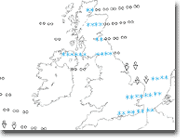Modelo:
MERRA (MODERN-ERA RETROSPECTIVE ANALYSIS FOR RESEARCH AND APPLICATIONS)
Actualização:
hourly to monthly from 1980 to last month
Greenwich Mean Time:
12:00 UTC = 12:00 WET
parâmetro:
Kind of precipitation
MERRA:
The MERRA time period covers the modern era of remotely sensed data, from 1979 through the present, and the special focus of the atmospheric assimilation is the hydrological cycle. Previous long-term reanalyses of the Earth's climate had high levels of uncertainty in precipitation and inter-annual variability. The GEOS-5 data assimilation system used for MERRA implements Incremental Analysis Updates (IAU) to slowly adjust the model states toward the observed state. The water cycle benefits as unrealistic spin down is minimized. In addition, the model physical parameterizations have been tested and evaluated in a data assimilation context, which also reduces the shock of adjusting the model system. Land surface processes are modeled with the state-of-the-art GEOS-5 Catchment hydrology land surface model. MERRA thus makes significant advances in the representation of the water cycle in reanalyses.
Reanalyse:
Retrospective-analyses (or reanalyses) integrate a variety of observing systems with numerical models to produce a temporally and spatially consistent synthesis of observations and analyses of variables not easily observed. The breadth of variables, as well as observational influence, make reanalyses ideal for investigating climate variability. The Modern Era-Retrospective Analysis for Research and Applications supports NASA's Earth science objectives, by applying the state-of-the-art GEOS-5 data assimilation system that includes many modern observing systems (such as EOS) in a climate framework.






















